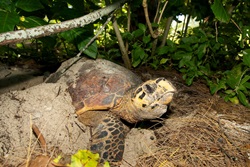
Marine turtles travel around the world to feed and mate, but as the saying goes, “there’s no place like home” and female turtles return to their place of birth lay their eggs. This behavior is called “natal homing”. In contrast, they feed in the open ocean alongside turtles from a variety of nesting populations. This includes some turtles that have travelled very long distances.
A new study of the hawksbill turtle (Eretmochelys imbricata) has identified signals of long-distance migrations across oceans. This study, led by Dr Sarah Vargas from the Molecular Ecology, Evolution and Phylogenetics Lab, has the most geographically comprehensive sample of hawksbill turtles to date. An international team of researchers analysed DNA from 492 turtles from 14 locations spanning over 13,500 km – more than the quarter of the earth’s circumference.
The team found connections between feeding grounds in the eastern Pacific (Colombia) and the Atlantic Ocean and nesting populations in the Indo-Pacific region. This included surprising evidence of long-distance migrations, with less natal homing than expected. Professor Simon Ho, who analysed the genetic data, noted that “there was evidence of a complex history of connections between populations of the hawksbill turtle”.
As with many other marine turtles, the hawksbill turtle is threatened by human activity. The species is exploited for its shell, eggs, flesh and whole animals are taxidermied for decoration. Successful conservation of this species relies on having a good understanding of its behaviour and distribution. Maintaining good levels of genetic diversity is also critical to protecting the species from extinction. “We have collected a vast amount of data to help the effective protection of this critically endangered, migratory species,” said Sarah.
A key outcome of the study, which will appear in an upcoming edition of the Journal of Heredity, is that hawksbill turtles of the Indo-Pacific can be divided into eight management areas for conservation purposes. Of these eight, three are in Australia – northeast Arnhem Land, north Queensland and Western Australia. Some of these eight management areas have low genetic diversity, including those in Western Australia and Peninsular Malaysia. These low-diversity populations have unique genetic variants, suggesting that they will be not replaced once depleted. International cooperation will now be required to manage these unique turtles.
Read the scientific publication here:
Phylogeography, genetic diversity, and management units of hawksbill turtles in the Indo-Pacific
Vargas, Jensen, Ho, Mobaraki, Broderick, et al. (2015) Journal of Heredity, 107: 199–213